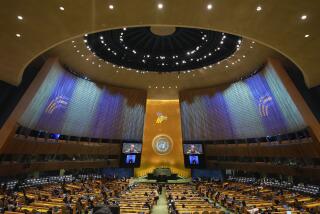Global Wildlife Summit Under Way : Environment: Officials from 124 nations gather in Florida to draft policy on endangered animal and plant species.
- Share via
It all started two decades ago with leopards, chimpanzees and crocodiles.
Now, as 124 nations convene in Florida to decide the fate of the world’s rarest and most coveted creatures, their mission has expanded in scope, encompassing more than 25,000 protected animals and plants--from orchids to tigers--that have been exploited for enormous worldwide profits.
Starting today, cabinet-level ministers and their entourage of several thousand delegates gather for a two-week summit to update and perhaps overhaul the world’s largest conservation treaty, the Convention on International Trade in Endangered Species of Wild Fauna and Flora.
Often pitting nation against nation, the pact is designed to halt the exploitation of wild creatures for profit--from elephants culled for their ivory to whales harpooned for their meat--by banning or restricting the lucrative trade of products from rare and exotic species.
On the eve of the first gathering in the United States since the treaty’s conception in 1973, each government is gearing up for politically charged decisions that are critical to many nations’ environments and economies.
“CITES is one of the longest-standing conservation treaties and by many accounts the most successful,” said Ginette Hemley, director of international policy for the World Wildlife Fund, a global conservation group.
“It has helped a number of species recover and helped countries maintain trade in a sustainable way,” she said. “But we need some real results, some real decisions from the countries attending this meeting. It takes political will to make CITES work and stop illegal trade.”
Several dozen controversial species are up for debate at the Ft. Lauderdale summit. Included are proposals to partially lift a ban on the export of African elephant products, proposed new restrictions on sale of mahogany from South America and Mexico, and Norway’s request to ease the ban on whaling by allowing trade in minke whales.
Many of these global feuds pit the wealthy United States, Western Europe and Japan--the major buyers of wildlife products--against poorer African and Latin American nations--the major exporters--that want to retain control over their own natural resources and sustain their economies.
“It is a difficult task because, in addition to the scientific information, one should take into consideration economic and enforcement problems, and even political concerns,” Obdulio Menghi, scientific coordinator of the CITES Secretariat, based in Geneva, said in a statement.
The U.S. delegation, headed by Interior Secretary Bruce Babbitt, has not yet decided its stance on the most heated issues, especially how to vote on South Africa’s elephant proposal. South Africa has petitioned to partially lift the 1989 ban on elephant trade by allowing sales of hide while retaining the ban on ivory.
The Clinton Administration wants to ensure its position does not jeopardize U.S. relations with South African President Nelson Mandela, so Vice President Al Gore will make the final decision based on input from Babbitt and other wildlife officials, members of the National Security Council and U.S. trade representatives.
South Africa is overpopulated with elephants due to that nation’s strong conservation efforts, and officials there say if they can sell some hides from culled herds, they will allocate the money to enhance their crackdown on poachers.
Most member nations agree with South Africa in theory, yet some worry that cracking open the window to limited trade could revive an uncontrolled rush of poachers and spur illegal sales of ivory. Conservation and animal-rights groups are divided on the proposal, too.
In many cases, the treaty has succeeded in protecting species, mostly through public-awareness campaigns in the richer Western nations. For instance, ivory products are decidedly unfashionable in the United States and Europe, causing a steep decline in elephant poaching since the creatures were unanimously protected in 1989. While Kenya lost up to 5,000 elephants per year during the 1980s, now fewer than 50 are killed annually, according to the Environmental Investigation Agency, a Washington, D.C.-based environmental group.
Babbitt’s team also has been divided on whether to vote to restrict sales of mahogany from Brazil and Mexico, a move that timber traders and U.S. furniture manufacturers have campaigned against.
The United States is the largest importer of tropical mahogany, a popular wood for furniture, but U.S. government officials are split on the issue. The U.S. Fish and Wildlife Service says the forests need protection, while U.S. forestry officials argue they do not. Babbitt reportedly has reached a decision, but the result has not been revealed.
Under the proposal, sale of mahogany would remain legal, but Mexico and Brazil would regulate its trade, which would cause a price hike and perhaps some shortages.
“The timber proposal is very hot. It has torn up the U.S. government internally,” Hemley said. “The Forest Service has come out with guns blazing.”
Before the delegates adjourn on Nov. 18, they also will wrestle with setting standards for deciding which species to protect and which ones to reject. Most of the nations, including the United States, want the decisions based on science rather than politics and emotions, while others are pushing for more flexibility.
The countries will also debate how to halt widespread poaching and black markets in violation of the treaty, oftentimes in countries that lack the will or funds to initiate conservation programs.
If a nation fails to enforce the treaty it signed, the others have the authority to impose trade sanctions. That, however, rarely occurs because of global political sensitivities and financial dilemmas.
For example, tigers in India and Russia’s far east, despite the treaty’s highest level of protection, are still being decimated by poachers who hawk the rare animals’ bones for use in Asian medicines. The rhinoceros is also near extinction because of an illegal, lucrative black market for its horns.
U.S. environmentalists fear that if the session adjourns without resolving enforcement dilemmas, Siberian and Bengal tigers and African rhinos could nearly be wiped out by the time the delegates convene again in two to three years. The World Wildlife Fund is urging wealthier nations to help Russia and India by offering financial aid and training.
When the accord was signed in Washington, D.C., in 1973, there were only 21 signatories, as varied as Brazil, the United Kingdom, Iran, South Africa and Thailand. The treaty now bans trade of more than 600 species and restricts it for more than 25,000 others.
More to Read
Sign up for Essential California
The most important California stories and recommendations in your inbox every morning.
You may occasionally receive promotional content from the Los Angeles Times.










